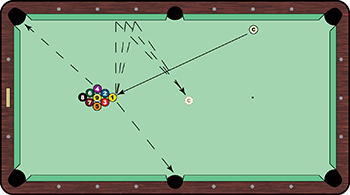Nothing will put some buzz back into your practice sessions like the anticipation of a big tournament. And after a lean playing schedule for me over the past two years, the upcoming U.S. Open 9-Ball Championship this April in Las Vegas has me really excited. It promises to be the biggest and greatest 9-ball tournament of all time.
Itís still more than a month away, but it is all I can think about and Iíve already started preparation. I plan to practice as hard as I ever have and will be playing several tournaments in Europe as part of that preparation, in part because all of these tournaments will be racking with the 9 ball on the spot, which will also be the format at the U.S. Open. I plan on being in great shape come April!
In the past few issues Iíve offered advice and drills for practicing the break in 9-ball and 10-ball, but the 9-ball discussion was based on the 1 ball being on the spot. Moving the 9 ball to the spot completely changes the break, making it more of a random break and resulting in less cue ball control. Still, the break is the key to success in 9-ball, so gaining some consistency is going to be essential. From now until the Open, I will practice and play only with the 9 on the spot and I plan to break for hours on end. When you are preparing for a 9-ball event, I suggest you also spend the bulk of your practice time on the break. Pattern play becomes less important if you never get to the table!
The diagram shows the path I want the cue ball to take. Amateur players might question why I would risk losing control of the cue ball to the right. By moving the 9 up to the spot, making the wing ball (in this case the 4 ball) becomes a lot more difficult. If you hit the 1 ball square in this format, the wing ball will hit the side rail about a diamond up from the pocket.

Additionally, the 1 ball will miss the side pocket to the high side as well.
The most effective break in this scenario is the cut break, but the three-point rule (at least three balls must pass the headstring or be pocketed) makes soft-breaking very dangerous. I will hit the break with medium-to-hard speed and just a fraction below center with a lot of right English. Iíve found that this approach gives me the best chance to pocket either the wing ball or the 1 (or both). What I like about this break is that you can adjust your speed and/or spin to find the best result. Once youíve found it, you are dialed in.
Also, I strike the cue ball like a pop break, aiming slightly off center on the 1 ball. The danger is in aiming too thin on the 1 ball because the cue ball will have a tendency to end up beneath the rack, and thatís no good.
Ideally, I would like the cue ball to come back to the center of the table, but thatís really tough to do consistently. My main goal is to avoid the scratch in the opposite side pocket. That is why the right English is so important.
When practicing, I start with medium power to work on my control. Then I add more power until I get the feel for the shot and see some consistency. The three lines in the diagram indicate my margin for a perfect cut break when the 9 ball is on the spot. Obviously, the key is to make balls on the break, but I like the 9 on the spot because you have no idea which ball will be the lowest-numbered ball remaining on the table. The game becomes more random and you see more strategy, safety play and shot-making than when the 1 ball is on the spot.
Once youíve practiced this break and understand the principles, you can start taking things into consideration like the age of the cloth. On older, worn cloth, I would probably aim around 4 oíclock on the cue ball. But new cloth will result in more slide, so I will avoid a below-center hit and strike the cue ball at 3 oíclock. Again, adjust until you find the contact point that produces pocketed balls and cue ball control.





